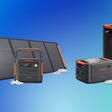Back in late November, iPhone case maker Urban Armor Gear sent an iPhone into space using a weather balloon, and in early January, the site shared a video depicting the iPhone's journey to the stratosphere in an Urban Armor Gear case.
The iPhone soared 101,000 feet into the atmosphere, and was subjected to 70 mile per hour winds and temperatures that dropped to -79 degrees Fahrenheit. Though turned on at launch, the iPhone later shut off and froze due to the cold weather.
Urban Armor Gear hooked the iPhone up to a weather balloon rig that also included a GPS locator and two GoPro cameras for filming. Upon descent, the iPhone and the flight rig withstood 150 RPM rotation speeds, and at landing, the rig broke while the iPhone managed to remain unscathed.
"Our cases already meet military drop-test standards, but now we can officially say that they are space tested as well," said Steve Armstrong, co-founder of Urban Armor Gear. "The fact that the iPhone survived its space adventure and returned fully functioning showcases our commitment in providing our customers world-class, or in this case out of this world, protection for their premium devices."
The iPhone was protected by an Urban Armor composite case which promises military-grade protection, but it did not have a screen protector and still managed to come out undamaged. After landing, the iPhone powered back on and was fully functional, demonstrating the durability and solid construction of the device.
























Top Rated Comments
The international definition of "space" is 100 km (about 61 miles, 328,000 feet.) The US Air Force used to use 50 miles (264,000 feet.)
Um, even in orbit around the dark (as in: unlit by the sun; separate from "back") side of the moon it doesn't get that close to absolute zero. The dark side of the moon (no atmosphere, no solar radiation for 14 days,) gets as cold as -243 F (-153 C.) Still well above absolute zero.
There are craters near the north pole of the moon that are permanently in shadow, so never receive any solar radiation. They can get as low as -413 F (-247 C,) colder even than Pluto. Still noticeably above absolute zero (which is -459 F, -273 C.)
So, especially right above the Earth's surface, where there is still measurable atmosphere (thin, yes, but it's thick enough for jet engines to work, and airfoils to provide lift and control, as evidenced by the fact that the SR-71 jet-powered spy plane could fly that high,) means it shouldn't be surprising that it isn't "near absolute zero."
In fact, it is often WARMER at 100,000 feet than at lower (but still high) altitudes. The standard model is that air temperature at 100,000 ft. is approximately 100 degrees (F) cooler than the sea level temperature directly underneath. But between 35,000 feet and 85,000 feet, it is often 130 degrees (F) cooler! So as you travel up, it gets colder and colder as you reach 35,000 feet, then stays about the same until you reach 85,000 feet, then starts to warm up as you get to 100,000 feet.
http://usatoday30.usatoday.com/weather/wstdatmo.htm
And actually, the drop consisted of only a few inches when it detached from the clamp after the rig hit the dirt. This really is a much better ad for GoPro.
Also, way to go GoPro. They kept recording even though the iPhone had to shut itself off. Their investors should take note; Apple doesn't have anything in their league regarding extreme conditions video capture.